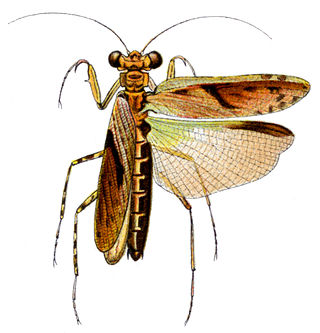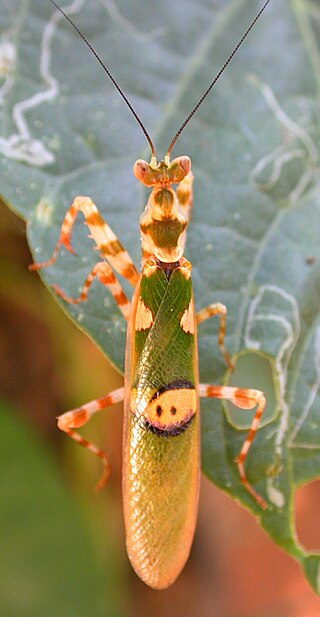
Mantidae is one of the largest families in the order of praying mantises, based on the type species Mantis religiosa; however, most genera are tropical or subtropical. Historically, this was the only family in the order, and many references still use the term "mantid" to refer to any mantis. Technically, however, "mantid" refers only to members of the family Mantidae, and not the numerous remaining families of mantises. Some of the most recent classifications have promoted a number of the mantid subfamilies to the rank of family, e.g. Iridopterygidae, Sibyllidae, Tarachodidae, Thespidae, and Toxoderidae, while other classifications have reduced the number of subfamilies without elevating them to higher rank.

Amorphoscelidae is a family of mantises in the order Mantodea.

Hymenopodinae is a subfamily of the mantis family Hymenopodidae that includes several species of flower mantises.

Creobroter is a genus of flower mantises in the tribe Hymenopodini; species are concentrated in Asia. The name comes from the Greek kreo-, meaning "flesh") and broter" meaning "eating", therefore, "flesh-eating", an apt name for a predatory insect. Both sexes have long wings and are capable fliers. Full-grown males are about 3 to 4 cm in length; females are about 4 to 5 cm.

Statilia maculata, common name Asian jumping mantis or "小蟷螂", ko-kamakiri or "좀사마귀", joem-sa-ma-gui, is a species of mantis native to Asia that can be found in Romania, China and Japan and Korea, Jamaica and Sri Lanka.

Hierodula patellifera, commonly known as giant Asian mantis, Asian mantis, Indochina mantis and Harabiro Mantis, is a species of praying mantis in the family Mantidae. They are found in Malaysia, Hawaii, India, Nepal, Italy, Indonesia, Korean Peninsula, Philippines, New Guinea, southern China, Taiwan, Vietnam, and Japan. H. patellifera lives in trees and in grasslands at the edges of forests.

Hierodula is a genus of praying mantids in the tribe Hierodulini, found throughout Asia. Many species are referred to by the common name giant Asian mantis because of their large size compared to other mantids. Their large size and vibrant coloration make Hierodula mantids popular in the pet trade. Some widespread species include H. membranacea and H. patellifera; however this has been considered a 'catch all' genus and is currently subject to review. In 2020, three species were moved to a new genus, Titanodula.

Sang piao xiao or Sangpiaoxiao is a Pinyin transliteration referring to the oothecae, or egg case, of the praying mantis as an ingredient in traditional Chinese medicine. A formula based on this ingredient is known as sang piao xiao san and is also known as "mantis formula" in English. The formula may also be sold as a pill.

The Chinese reddish mantis is a species of praying mantis in the family Mantidae.
Hierodula jobina is a species of praying mantis in the family Mantidae.

Hierodula majuscula is a species of praying mantis in the genus Hierodula. It is also known as the giant rainforest mantis and the Australian giant mantis. It is found in coastal northern Australia, usually in rainforest and adjacent habitats. This species is typically green although a less common bright yellow form does occur.
Hierodula parviceps is a species of praying mantis in the family Mantidae, also known as the Marbled Mantis and is native to Southeast Asian countries such as the Philippines.
Hierodula purpurescens is a species of praying mantis in the family Mantidae.
Hierodula rajah is a species of praying mantis in the family Mantidae.
Hierodula ralumina is a species of praying mantis in the family Mantidae.

Hierodula tenuidentata is a species of praying mantis, sharing its common name giant Asian mantis with other large members of genus Hierodula in the family Mantidae. It is native to India, and has been introduced to Greece and elsewhere in southern Europe, including Hungary, Romania, and Serbia.
Hierodula versicolor is a species of praying mantis in the family Mantidae.

Statilia is a genus of praying mantis that resembles dead or living grass. Statilia species live in Australia, Africa, Asia and islands.

Humbertiella is a genus of praying mantids in the subfamily Gonypetinae found in Asia.













